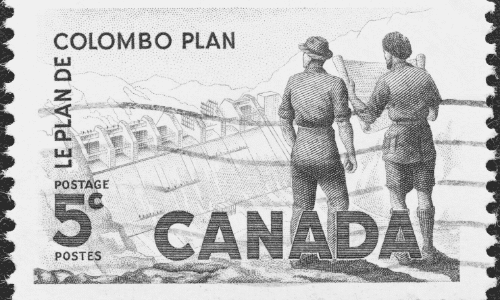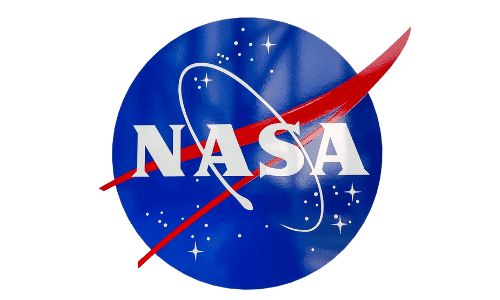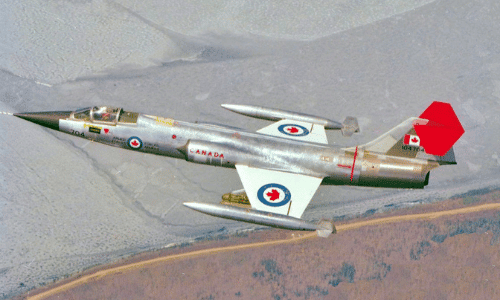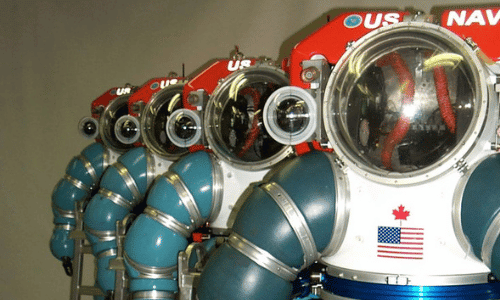We’ve been helping Canadian exporters succeed internationally for over 75 years.
Since Canadian Commercial Corporation was founded in 1946, we have facilitated trillions in exports and foreign investment by Canadian companies. Our story has touched thousands of Canadians.

Credit: Globe and Mail
1946 | The world needs Canada
In the aftermath of World War II’s devastation, the Rt. Hon. C.D. Howe, then Minister of Reconstruction and Supply recognized the urgent need to assist with clothing, food, and housing for millions of displaced persons, along with rehabilitation of war-torn Europe and other parts of the world. The Government of Canada temporarily provide the then Export Control Board powers similar to the UK and US Commercial Corporations, to create an organization that could purchase and deliver within critical time limits the urgently needed Canadian resources.

Credit: Globe and Mail

Credit: Bundesarchiv, Bild
1946 | Creating the Canadian Commercial Corporation
On August 31, 1946, An Act to Establish the Canadian Commercial Corporation receives Royal Assent, officially creating CCC as a Crown Corporation. CCC assumed the responsibilities of carrying out procurement functions from Canada on behalf of various foreign governments, as well as the United Nations Relief and Rehabilitation Administration (UNRRA). Major shipments and projects include sending 23,700 horses to Europe, $4 million in automotive parts to UNRRA, $4 million in steel bridging to China and $62 million of ship construction for France. The Corporation also assumed the role of prime contractor to the United Nations International Children's Emergency Fund (UNICEF), now known as the United Nations Children’s Fund.

Credit: Bundesarchiv, Bild

Wikimedia Commons
1947 | Supplying North American National Defence
In February 1947, the Corporation was given the powers, duties and functions to purchase the requirements of the Department of National Defence (DND) until the creation of the Department of Defence Production in 1951. At the same time, CCC supplied allied foreign governments with Canadian goods, in particular the requirements of the United States military. This was one part of the common defence effort of the two countries pursuant to the Hyde Park Agreement, and continues to be one of CCC’s major activities. Learn more.

Wikimedia Commons

Toronto Star Photograph Archive - Public Domain
1949 | National Defence Construction Contract
To meet the needs of Canada’s armed forces, CCC contracted for the construction of 1, 624 military houses for an aggregate value of $19M at the time. In view of the large defence construction needs, another crown corporation was created, Defence Construction Limited, to handle all new construction work on behalf of the Department of National Defence, while CCC continued contracting work for repair and maintenance.

Toronto Star Photograph Archive - Public Domain

Credit: NATO Hulton Archives, HB-7277
1949 | Canada signs the North Atlantic Treaty
On 4 April 1949, Canada joins Belgium, Denmark, France, Iceland, Italy, Luxembourg, the Netherlands, Norway, Portugal, the United Kingdom, and the United States in signing the North Atlantic Treaty. Together, they pledged mutual defence, but also - at Canadian insistence - social and economic cooperation. For the first time in its history, Canada had joined a peacetime military alliance. CCC was assigned the role of fulfilling Canada’s strategic materials as part of some of its obligations to NATO.

Credit: NATO Hulton Archives, HB-7277

Credit: Bruce Forsyth
1951 | The Pinetree Radar Line & NORAD
In 1951, the Pinetree Radar Line construction commenced as a joint Canada - USA project. This line, which featured a total of 44 radar stations, stretched along the 50th parallel, down the eastern coast and into southern Ontario and Quebec, and acted as an early warning detection system Radar early warning stations were placed to counter the Soviet air threat against North America. This later became part of the joint US-Canada North American Air Defence (NORAD) System. The Corporation acted as prime contractor for equipment and services as part of this project.

Credit: Bruce Forsyth

1952 | Canada’s contribution to the Colombo Plan
The Corporation accepted the responsibility for purchasing and shipping material and good required for the Government of Canada’s contributions to the governments of India, Sri Lanka (known then as Ceylon) and Pakistan. CCC contracted supplies, services and projects including irrigation and hydro-electric projects; the construction of a cement plant; the provision of agricultural machinery; trucks and buses; fishing boats and trawlers; livestock equipment and veterinary services; flour; diesel locomotives; and laboratory equipment for a university.
This was just the beginning of CCC’s role as the Government of Canada’s contracting, procurement and project management partner to deliver Canada’s in-kind contributions to foreign recipients all around the world.


Credit: Globe and Mail
1953 | Canada responds to South Korea’s needs
Following the July 1953 armistice that ended the Korean war, CCC entered into an agreement with the United Nations Korean Reconstruction Agency to act as its purchasing agent in Canada. As a result of the agreement, that year the Corporation contracted $5M worth of goods, starting with 500 tons of paper and 66 thousand tons of barley.

Credit: Globe and Mail

Credit: Toronto Star
1954 | The polio epidemic
By 1953, Canada reached epidemic levels with nearly 9,000 cases and 500 deaths caused by polio (poliomyelitis). As research toward a successful vaccine continued, the purchase of rhesus monkeys was required by the Connaught Medical Laboratories in Toronto for the manufacture of the Salk polio vaccine. At the request of the Department of National Health and Welfare, and with the co-operation of the Government of India, the Corporation made arrangements to transport the animals with measures to ensure top physical condition. Less than 1% of the 1,500 animals failed to survive the 10,000 mile journey. The success of the immunization programs in the 1950s dramatically reduced the incidence of polio in Canada, leading to the last indigenous case in 1977 and eradicating the disease by 1994.

Credit: Toronto Star

1955 | The hurricane of the century
On October 5th, hurricane Hazel hit North America and left more than a thousand dead, mostly in Haiti and caused over $3 billion (in 2012 dollars) in damages from the Caribbean to Canada. On behalf of the Department of External Affairs, the Corporation purchased and shipped $25,000 worth of dried salt codfish to Haiti as a relief measure.


1956 | Defence Production Sharing Agreement
The Defence Production Sharing Agreement was signed in 1956 between the United States and Canada to ensure the most effective use of U.S. and Canadian defence-related industrial capabilities. This led to the creation of the 1958 Canada-USA Defence Production Sharing Programme, carried out by CCC. It is designed to increase opportunities for Canadian industry to compete alongside U.S. counterparts for prime defence contracts issued by the U.S. military. The programme is based on the policy that, as far as practicable, the resources of the two countries should be coordinated for the common defence of North America and that there should be economic co-operation in the production of defence requirements. This principle was initially recognized by both countries as part of the 1941 Hyde Park Declaration and reaffirmed in the 1950 Statement of Principles for Economic Co-operation".


1960 | Worldwide emergency relief
On May 22, 1960, the most powerful earthquake in recorded history, magnitude 9.5, struck southern Chile, leaving two million people homeless, injuring at least 3,000, and approximately 1,655 deceased. At the request of the Department of External Affairs, the Corporation purchased 9,800 tons of flour as a donation from Canada to the Government of Chile for earthquake relief purposes.
That same year, following unrest in Lebanon and Egypt, in response to a humanitarian crisis, the Corporation sent 28,300 tons of flour through the United Nations Relief and Works Agency. As part of NATO collaboration, 19,000 tons of flour was shipped to address the famine in Norway, and 30,000 tons to address the famine in the United Kingdom.


1961 | Canada joins the U.S. “Space Race” effort
In May 1961, U.S. President John F. Kennedy proclaimed "First, I believe that this nation should commit itself to achieving the goal, before this decade is out, of landing a man on the moon and returning him safely to the Earth." Fuelled by competition with the Soviet Union, this mission was dubbed the "space race". Canada quickly joined forces and an agreement was signed between Canada and the U.S. National Aeronautics and Space Administration (NASA), setting out the terms and conditions for the Corporation to act as prime contractor for material and technologies from Canada. Some of Canada’s first contributions were for a “Minitrack” Satellite Tracking Station and the design and fabrication of a prototype erectable antenna unit.


Credit: Royal Canadian Air Force
1964 | Providing tactical and fighter aircrafts to the U.S.
On July 2, 1959, after the F-104 was selected by the Royal Canadian Air Force to replace the Sabre Mk.6 used to support NATO operations in Europe during the Cold War. Under license from Lockheed, Canadair produced the F-104 aircraft for our country but also produced a later version, the F-104G on behalf of the U.S. Government. The Corporation managed the $59M order, along with a $37M order for the de Havilland Caribou aircraft to provide tactical military transport.

Credit: Royal Canadian Air Force

1967 | Providing tactical ground support aircrafts to the Netherlands
In early 1967, the Netherlands Government joined Canada in procuring the Canadian produced CF-5 tactical ground support aircraft by Canadair. The $145M order for 105 aircraft was purchased through CCC’s Government-to-Government contracting service. The Royal Dutch Air Force received their order of 75 renamed NF-5a single seater aircrafts and 30 NF-5b two-seater trainer aircraft in March 1969.


1974 | Railway transportation in Africa
From 1974 to 1979, Malawi worked with the Canadian International Development Agency (CIDA) through CCC as prime contractor to build 110 kilometres of new track from Salima to Lilongwe though the Malawi-Canada Railway Project. CCC also procured specialized commercial transportation railway cars for Zambia.


1979 | Canadarm - Canadian ingenuity in Space
At first called the Shuttle Remote Manipulator System (SRMS), the now commonly known Canadarm was a remote-controlled mechanical arm, contracted through CCC for NASA by Spar Aerospace Limited of Toronto (acquired by MDA in 1999). The $110M Canadarm development program was carried out under the direction of the National Research Council of Canada, and led by Spar Aerospace Ltd., included CAE Electronics Ltd. and DSMA Atcon Ltd. The Canadarm was signed over to NASA in 1981 in Toronto, where it was built. Considered the first space robotics, the Canadarm had a productive 30-year career with NASA’s Space Shuttle Program where it deployed, captured and repaired satellites, positioned astronauts, maintained equipment, and moved cargo. Although the Canadarm was retired in July 2011, it established Canada’s reputation as a leader in technological innovation and inspired a series of other Canadian robotics used on the International Space Station, including Canadarm2.
Sourced in part through The Canadian Encyclopedia


1982 | Helping to address world health issues
River blindness is a terrible disease that causes severe discomfort and eventual blindness among infected people. The flies that spread river blindness breed in fast-flowing water, and caused fertile land in Africa, fed by rivers such as the Volta, to be unsafe for agriculture as for decades. Viking Helicopters and CCC was awarded three $7.6M contracts from the World Health Organization for the spraying of the rivers to help control the disease.
That same year, Connaught Laboratories and CCC was awarded a contract on behalf of the UNICEF for the establishment of a measles vaccine plant in Pakistan.
CCC was also awarded a $19M contract with the Foundation Company of Canada Ltd of Toronto to build a 215-bed hospital in the Ivory Coast. The hospital was opened on schedule in November 1984, and a subsequent $1.5M extension was required for the provision of services for initial management and medical equipment.


1984 | First commercial sales to Ecuador
A $10.1M contract involving electronic teaching aid equipment for Ecuador was awarded via CCC’s Government-to-Government contracting service to Lab-Volt Ltd, now Festo-Didactic.


1985 | Hong Kong “world’s busiest seaport”
Following the completion of a Vessel Traffic Management Study for the Port of Hong Kong through CCC, the Hong Kong Marine Department requested that the Corporation, in collaboration with the Canadian Coast Guard, select through a competitive process a Canadian contractor to implement the study. The Request for Proposal process resulted in the selection of DGB Consultants Inc., of Montreal signing a USD $19M contract for the establishment of a comprehensive vessel traffic system for the harbour and waterways of Hong Kong.


1988 | Caribbean early-warning weather radars
CCC contracted with the World Meteorological Organization for the refurbishment of Weather Radar Systems in Jamaica and Barbados. At the time state-of-the-art technology, these radars were part of a network of early-warning system for any tropical storms, hurricanes and other severe weather that affect the region. CCC completed the work with Genelcom Ltd, from Weston, Ontario, a communications subsidiary of GE Canada Inc.


1990 | Unique musical contract with New Zealand
Representing one of the few non-governmental transactions in CCC’s history, in 1990, the Waikato Anglican Boys’ College Trust from Hamilton, New Zealand, acquired a pipe organ via CCC from Les Orgues Létourneau Ltd, of St. Hyacinthe, Québec. Given the uniqueness of the pipe organ, Les Orgues Létourneau is one of the few businesses that designs, builds and restores pipe organs in the world.
This successful contract led to the further sale of pipe organs destined to several churches across the United States and Australia in the early 1990s.
With these contracts, CCC can confirm that we helped to bring more music to the world!


Credit: Weatherhaven
1991 | United Nations uses Canadian shelters to for humanitarian assistance
Several United Nations agencies required soft-wall shelters to use for various operations as field hospitals or to house internationally displaced persons. CCC, working with Weatherhaven based out of Vancouver, B.C. were chosen as the suppliers. Weatherhaven’s strong reputation and proven expertise led to further contracts for these redeployable shelter systems over the years.

Credit: Weatherhaven

1991 | CCC signs MOUs with Cuba
In 1991, the Government of Canada, through CCC signed two Memoranda of Understanding with the Cuban Ministerio de Turismo and the Ministerio del Azúcar (MINAZ) effectively launching the CCC Cuba program, that continues to this day. Through this program, CCC has been successfully managing Canadian exporter contracts using its unique government-to-government prime contractor service. Over the past 30 years, Canadian exporters, 80% being small and medium enterprises (SMEs), have provided the Government of Cuba with a variety of consumer goods and services that have supported the island nation’s agricultural and tourism sectors. Examples of the goods and services provided include, but are not limited to, Canadian frozen beef, construction supplies, fertilizer for Cuba’s sugar harvest, and water softeners for Cuban hotels.
This program is made possible through a partnership between CCC works, Export Development Canada (EDC) and the National Bank of Canada (NBC), together providing a made-In-Canada financing and contracting solution for Cuban buyers.


1991 | CCC helps bring IMAX to the world
A unique, state of the art technology for the movie business, IMAX Corporation from Toronto, Ontario worked with CCC on a contract for tis highly visible OMNIMAX projection and sound system to Phantasialand in Bruhl, Germany.
Shortly after this success, a similar contract was signed to install the same system in Tel Aviv, Israel in 1992.


1993 | Thailand purchases Canadian helicopters
A major sale through CCC to the Royal Thai Armed Forces of Bell 212 helicopters manufactured by Bell Helicopter Textron, a division of Textron Canada Ltd. The contract called for the sale of twenty Bell 212 helicopters manufactured at the company’s headquarters in Mirabel, Quebec. This sale was especially illustrative of the usefulness of a government-to-government contract, which greatly reduced the complexity of the transaction for all parties concerned.


Credit: OceanWorks International
1994 | Canadian diving innovation wins U.S. defence contract
International Hard Suits Inc, now OceanWorks International, of North Vancouver, B.C., developed world leading diving suit technology. Called the Newtsuit, it was sold successfully to the French, Italian, and Canadian navies as well as the Japanese Defence Force. Through CCC’s U.S. DoD Prime Contractor Service, International Hard Suits Inc. Was able to sell to their largest potential customer: the U.S. Navy. The final result was a $1M contract. Working with CCC led to over $20M in sales over the next five years, making the U.S. Navy a cornerstone customer for this innovative diving suit.

Credit: OceanWorks International

1996 | CCC launches Progress Payment Program (PPP)
CCC launched the Progress Payment Program (PPP), helping CCC customers confidently sell to a diverse range of non-traditional markets, this service helps smaller exporting companies gain access to pre-shipment export financing from commercial sources. This bridges the cash flow gap for companies by helping them secure pre-shipment export financing from one of 19 participating financial institutions through a project line of credit to cover production costs for a particular export sale. The Progress Payment Program was discontinued in 2005-06 in order to eliminate duplication with services offered by Export Development Canada.


1996 | CCC launches Bid Matching System
Also in 1996, CCC launched a new Bid Matching System, where the Corporation proactively makes Canadian companies aware of U.S. opportunities. Vetted opportunities are posted on the Canadian MERX system and CCC’s website at the time, with a keyword search function. Within two years, the new Bid Matching System is attributed as significantly increasing the pipeline of proposals to the U.S. government market, reporting that 663 Canadian companies solicited bids valued at $766M, generating contracts valued at $85M. This idea was revisited in 2003-04 as SourceCan, where opportunities were matched for U.S. and European contracts.
Twenty-five years later, this idea is re-born and expanded for the entire world using the latest digital technology. CCC’s Global Bid Opportunity Finder covers over 200 countries and adds over 5000 opportunities daily.


1997 | Budapest International Airport needs a new terminal
In the summer of 1993, a Hungarian air traffic forecast demonstrated that Budapest’s Ferihegy International Airport ability to handle handling 4 million passengers a year within its two terminals, would prove insufficient for the projected growth by the year 2000. Through CCC’s government-to-government prime contracting service, Toronto’s Airport Development Corporation led the construction of Terminal 2B, starting in 1997. The new building, with an area of more than 30 000 m2 and with an adjoining apron, were opened on 8 December 1998. This was CCC’s first airport infrastructure project, and the valuable contracting experience gained benefited future airport contracts in other parts of the world.


1999 | Cancer Care in Costa Rica
Canadian expertise in the area of cancer care is internationally recognized. In 1999, under a US $1.5M government-to-government contract between the Government of Costa Rica and CCC, Toronto-based Cancer Care International (CCI) carried out the concept and financing study providing recommendations for developing a comprehensive oncology system, including the construction of a US $40M cancer treatment hospital in San José.


Credit: Aecon Group Inc.
2005 | Canada to build Quito, Ecuador’s International Airport
CCC signed a U.S. $440M contract to act as prime contractor for the construction of the new Quito International Airport in Ecuador. The Government of Canada, through CCC, assured that this project would be completed on time, within budget, and according to the quality standards stated in the contracts between CCC and the local municipal entity, Corporacion Aeropuerto y Zona Franca del Distrito Metropolitano de Quito, and the domestic contract between CCC and the Canadian construction firm, Aecon.
CCC and Aecon successfully delivered a new airport project in Quito, Ecuador in 2013. Quito’s new Mariscal Sucre International Airport has over a dozen international awards celebrating its innovative design and overall operations efficiency as a leading South American airport.

Credit: Aecon Group Inc.

2006 | Norway C-130E Hercules needs some TLC
When the Royal Norwegian Air Force needed to purchase parts and overhaul services for their C-120E Hercules aircraft, they approached CCC to act as their procurement agent to work with L-3 SPAR Aerospace Ltd. From Edmonton, Alberta. This contract, valued at U.S. $41.3M, involved the refurbishment of four C-130E transport aircraft. The Norwegian government preferred this method because CCC was able to put Canadian contracting practices and capabilities to use in order to accelerate the purchasing process and support the Norwegian procurement capacity. By meeting an allied military’s needs, CCC reinforced international relationships for the benefit of Canadian exporters and the Government of Canada.


2006 | Dominican Republic canal infrastructure Phase I
The Corporacion del Acueducto y Alcantarillado de Santo Domingo (Water and Sanitation Corporation) needed to find a viable solution to problems related to garbage strewn in the open-air canals of the storm and sanitary drainage systems that were causing regular flooding in the west end of Santo Domingo, the capital of the Dominican Republic. It turned to Dessau, a leading Canadian engineering and construction firm to lead this first phase of three through a prime contract with CCC. The $110M project involved redeveloping the area by replacing the open-air canals with underground storm and sanitary drainage systems. Dessau is headquartered out of Montreal, Quebec.


2008 | Germany commissions an earth observation satellite
In 2008, MacDonald, Dettwiler and Associates Ltd. (now MDA) led the design, build, launch and commissioning of an earth observation satellite constellation for RapidEye AG of Germany. This $187M contract was made possible through CCC’s government-to-government prime contracting service, that proved particularly useful to handle the many complex technical components of this project.
On August 29, 2008, a Dnepr rocket was successfully launched from Kazakhstan carrying RapidEye's constellation of five Earth observation satellites. Each satellite is identical and traveled on the same orbital plane (at an altitude of 630 km and separated in orbit by 19-minute intervals). These satellites were the first commercial satellites to include Red-Edge band technology, which is sensitive to changes in chlorophyll content. This is particularly used to monitor vegetation health, measure protein and nitrogen content in biomass, and other agricultural information needs.


Credit: Viking Air
2010 | Growing the Canada-Peru Bilateral Relationship
In 2010 CCC signed the first of three new contracts with the government of Peru. The growing relationship with this key regional partner resulted in a Peruvian Ministry of Defence (MoD) decision to engage CCC in late 2010 for the procurement of 12 new Twin otter aircraft through Viking Air limited of Sidney, British Columbia. The fact that the Peruvian MoD derived benefits from an expedited procurement, a transparent process, and from our rigorous supplier standards, was noted by other Peruvian government departments. The Peruvian Ministry of the Interior contacted CCC in 2011 to explore the areas in which CCC and innovative Canadian companies could help improve Peru's defence and security infrastructure. CCC has since signed contracts with: forensic Technology Inc., of Montreal, Quebec, to supply an Integrated ballistic Identification System; and with Morpho Canada Inc. of Montreal, Quebec, to supply an Automated fingerprint Identification System to Peru's Ministry of the Interior

Credit: Viking Air

Credit: Bluedrop Performance Learning Inc.
2011 | Australia looked to Canada for aircraft training simulators
Through CCC’s International Prime Contractor Service, Bluedrop Performance Learning Inc. was awarded a $1M contract to provide Virtual Reality based simulation to the Royal Australian Air Force (RAAF). This simulator supports the RAAF’s C-130J Hercules Loadmaster Training Program. The new contract will allow loadmasters to perform procedural training in a realistic immersive virtual environment simulating both day-time and night vision goggle assisted flight, with a primary focus on threat detection and reaction.
“This contract award clearly demonstrates Bluedrop’s ability to integrate and deliver world-class technology to military forces around the globe from Atlantic Canada.” said Allen Dillon, Bluedrop’s Vice President of Business Development.
In 2013, the success of the first contract paid off with a second contract awarded to Bluedrop for continued virtual reality training simulator services to the Royal Australian Air Force. Founded in 1992, Bluedrop has over 120 employees and is headquartered in St. John's, NL.

Credit: Bluedrop Performance Learning Inc.

2011 | Honduras & Nicaragua national lotteries
Honduras and Nicaragua were seeking a secure and modern online solution for their national lotteries. Through Prime Contracts with CCC, Ottawa, Ontario based Canadian Bank Note developed and operated expert and secure systems for the lottery marketplace. This has helped the Governments of Honduras and Nicaragua generate funds from the countries’ respective national lotteries to fund social programs, including maternal and child health and social care, and educational and social programs for the youth and senior populations.


2013 | Aircraft MRO in Mexico
In 2013, CCC, working with Cascade Aerospace, signed a $35 million government-to-government (G2G) contract for Programed Depot Maintenance on two C-130K Hercules aircraft with the Mexican Air Force. the competitive tender that was initially issued by Mexico for this procurement did not receive any qualifying bids. The Mexican Ministry of Defense (MoD) then proactively expressed interest in Cascade, and contacted CCC to explore the possibility of a G2G arrangement. The added security of the Government of Canada guarantee of contract performance, a characteristic of every contract CCC signs, coupled with the expedited pace of government-to-government contracting, encouraged Mexico to procure these maintenance services from Canada. Building on the success of the 2013 contract and on the confidence the Mexican Air Force had entrusted with Cascade, CCC and Cascade signed another $16.4 million contract in 2014 for the overhaul of engines in two C-130K Hercules aircraft.


2014 | Ebola crisis in Africa
In 2013, the outbreak of the Ebola virus in Western Africa, was the most widespread outbreak of the disease in history and caused major loss of life and socioeconomic disruption in the region, mainly in Guinea, Liberia, and Sierra Leone. In support of the Government of Canada’s humanitarian assistance, Global Affairs Canada (at the time the Department of Foreign Affairs, trade and Development), through CCC, assisted the World health Organization (WHO) by organizing the delivery of personal protective equipment (PPE) that had been donated by the Public Health Agency of Canada (PHAC), health Canada and eight Canadian provinces. At the height of the Ebola crisis in mid-2014, CCC rapidly identified and concluded supply arrangement agreements with reputable shipping providers to pick up approximately 18.5 million PPE items, located across Canada, for onward, coordinated forwarding to West Africa.


2014 | Bangladesh buys Canadian Potash
On April 23, 2014, CCC, working with Canpotex Ltd. signed a $41.3 million contract with a $20 million option to supply Bangladesh with potash over a 12-month period. As one of the world’s largest producers of potash, Canada accounts for 30% of the mineral’s total global production. Canada holds 46% of the world’s potash reserves in the Prairie Evaporite Deposit, which lies beneath the southern plains of Saskatchewan. Canada’s potash industry employs approximately 5,000 Canadians. Having been challenged and delayed by the procurement regulations of a direct-sale to Bangladesh, Canpotex approached CCC for a better solution. Through its government-to-government prime contracting service, the CCC joined Canpotex in this endeavour, leading to the first of several contracts for potash destined to the Government of Bangladesh.


2015 | Barbados in need of a cleantech water metering solution
In 2015, CCC signed a $42M contract with the Barbados Water Authority (BWA) to work with Canadian supplier Cowater-Sogema International for the implementation of a smart water meter system. This country-wide initiative brings important improvements to overall customer service through more accurate water bills, faster response times, improved client record management, increased fairness among consumers, earlier identification of leaks, replacement of broken water meters, improved transparency, and ultimately increased consumer confidence in the BWA. These improvements are expected to contribute towards building Barbadians confidence in the accuracy of the system, increasing their willingness to pay for water supplied by the BWA amongst household and commercial customers.


Credit: The Africa Logistics
2016 | Ghana in need of a new port terminal
In 2016, the Ghana Ports and Harbours Authority (GPHA) signed a USD $110M with the Government of Canada, through CCC’s International Prime Contractor Service. This project was led by Canadian construction firm JV Driver, based out of Leduc, Alberta. The project took 5 years to complete, opening its doors on time and on budget in March 2021. The world class terminal sits on a 16.2 hectares’ land and it consists of a 105,000m2 of container storage and devanning area, a car storage area, control tower, water tanks, transformer house, mechanical shop, fire bay, container freight station, an office complex, banking hall, a cafeteria and an outdoor parking area among others.
“The project’s successful completion is a demonstration of Ghana’s strong bilateral cooperation with Canada.” said Kati Csaba, Canadian High Commissioner to Ghana
“CCC is proud to have partnered with JV Driver and the Ghana Ports and Harbour Authority to deliver such an important infrastructure project, whose benefits will be felt by Ghanaians for decades,” said Bobby Kwon, President and CEO of CCC.
“JV Driver is honoured to have been entrusted with such a complex project that will have a transformative impact on Ghana’s trade activities and broader economy,” said Todd Patterson, Senior Vice President of JV Driver.

Credit: The Africa Logistics

2017 | Aecon redevelops Bermuda’s International Airport
With the roof leaking into the arrival halls, Bermuda’s national airport was badly in need of an upgrade. Canada’s Aecon Group had the right solution for the largest infrastructure project in the island nation’s history. When CCC offered a government-to-government (G2G) contract, it was exactly what the Bermudian government needed to take the leap. The $274-million construction project broke ground in April 2017, far enough away from the existing airport that it can continue to operate until the new terminal opens. Throughout the 40-month build, Aecon has used mainly local contractors, and almost 90% of Skyport’s airport employees are Bermudian.
Aecon incorporated state-of-the-art technologies into the design to ensure hurricane resistance and to maximize employee and client health and safety.
On December 9, 2020, Aecon, Skyport, CCC and Bermuda celebrated the opening of the new, state-of-the-art passenger terminal building at the LF Wade International Airport. Completed on budget, on time and exactly to specifications, this new modern 288,000 square foot facility provides improved passenger processing, increased passenger capacity, greater resilience to extreme weather conditions, modern amenities and infrastructure, energy efficiencies, advanced security, enhanced specialty retail and food & beverage outlets, and covered passenger jet bridges.


Credit: De Havilland Aircraft of Canada Limited
2018 | Bangladesh in need of Canadian Dash 8-400 aircraft
In 2018, CCC partnered with Canadian aircraft manufacturer De Havilland Ltd to conclude a purchase by Biman Bangladesh Airlines for three Dash 8-400, to augment their existing fleet of Dash 8-400 aircraft. With its low carbon footprint and operating costs, the Dash 8-400 aircraft is the environmentally responsible choice for operators seeking optimal performance on regional routes. The aircraft seats up to 90 passengers and offers industry-leading experience, and jet-like performance.

Credit: De Havilland Aircraft of Canada Limited

2019 | Bolivia needs help with Amazonian rainforest fires
In September, 2019, CCC signed an agreement with Coulson Aircrane Ltd. (Coulson) to assist the Government of Bolivia with its firefighting efforts in Chiquitania, a region of tropical savannas close to the Bolivian Amazon rainforest. As part of this contract, Coulson supplied a crew and three helicopters, including two Sikorsky S-61 helicopters and a custom Chinook CH-47D, to Bolivia to provide aerial firefighting capabilities. The facilitation of this transaction through CCC’s unique government-to-government contracting mechanism enabled Coulson to mitigate business risks, respond to an urgent environmental and humanitarian need and build on their existing business relationship with Bolivia.
Coulson is a 60-year-old, privately owned family company based in Port Alberni, British Columbia, Canada. As a global aviation company and world leader in aerial firefighting and heavy lift operations, Coulson has a diverse fleet ranging from large air tankers to large helicopters.


Credit: Bell Textron Canada and the Montenegro Air Force
2020 | Montenegro buys Canadian Bell helicopters
In June 2020, CCC announced the sale of two Bell 505 Jet Ranger X’s to the Montenegro Air Force, manufactured by Bell Textron Canada at their facility in Mirabel, Quebec. The sale, facilitated by CCC as Prime Contractor through our government-to-government contracting approach, will provide aircrafts that offer increased situational awareness and safety, allowing pilots to focus on training.
CCC is thankful to our international trade partners who helped to advance this contract, including our colleagues at Global Affairs Canada and our partners at the Embassy of Canada to Serbia, North Macedonia and Montenegro. The first of these aircrafts were delivered in June 2020, and the second in January 2021.

Credit: Bell Textron Canada and the Montenegro Air Force

Credit: Global Affairs Canada
2020 | Canada’s Humanitarian Response in the Global Fight Against COVID-19
In May 2020, as part of the Government of Canada’s response to the global pandemic, Global Affairs Canada (GAC) and CCC contracted services from Singapore-based GAIA Science PTE Ltd. to provide necessary products that can help protect against COVID-19.
CCC assisted GAC with the successful completion of these two separate contracts in August 2020, delivering 400,000 N95 respirator masks to the Africa Centres for Disease Control and Prevention, which in turn distributed the masks to African member states with the greatest need; and provided 690,000 items of Personal Protective Equipment to ASEAN partners, including 90,000 surgical masks for the ASEAN Secretariat and a total of 600,000 N95 masks for Brunei, Laos, Malaysia, Myanmar, Philippines and Vietnam.

Credit: Global Affairs Canada

2020 | CCC launched Global Bid Opportunity Finder
In order to assist small and medium enterprises across Canada to find more international sales opportunities, CCC launched its newest service, the Global Bid Opportunity Finder (GBOF). This web application is a single source for information about more than 5,000 tender opportunities in over 200 countries. And it’s free to use. GBOF searches 30+ e-tendering sources to connect Canadian businesses with bid and proposal requests through an easy-to-use portal. Users can search for opportunities by country, region, industry, or keywords specific to your company’s capabilities. Then set-up email alerts for bid opportunities that match specific search terms.
GBOF is a safe, convenient way to maintain or accelerate business development activities while COVID-19 travel restrictions are in place. Plus, it offers quick links to resources and online tools from EDC, the Business Development Bank of Canada (BDC) and the Trade Commissioner Service (TCS),


2021 | U.S. C-130J Aircraft MRO by Cascade Aerospace
In February, 2021, CCC announced that Cascade Aerospace has been awarded a contract with the U.S. Department of Defense (DoD) for the installation of critical upgrades to C-130J cargo aircraft. Valued at up-to USD $45 million, the contract provides for installation of government provided BU 7.0/8.1 kits in C-130J aircraft operated by the U.S. Air Force. The work will be performed at Cascade Aerospace’s facilities in Abbotsford, BC, and is expected to be completed by October 2025.
CCC is proud to support Canada’s aerospace sector to access the world’s largest military procurement market, the U.S DoD. Under the Canada-U.S. Defence Production Sharing Agreement (DPSA), Canadian exporters can compete for contracts with the U.S. DoD on an equal footing with U.S. suppliers.


